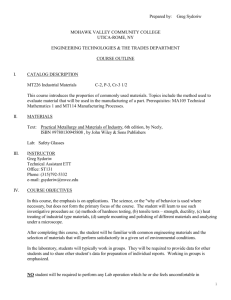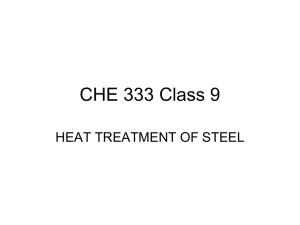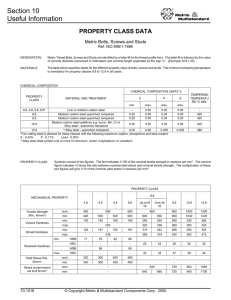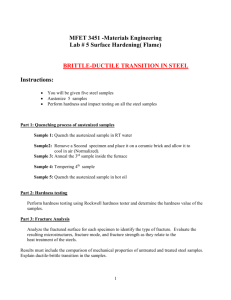Effect of Tempering Temperature on Mechanical Properties of Medium Carbon Steel
advertisement
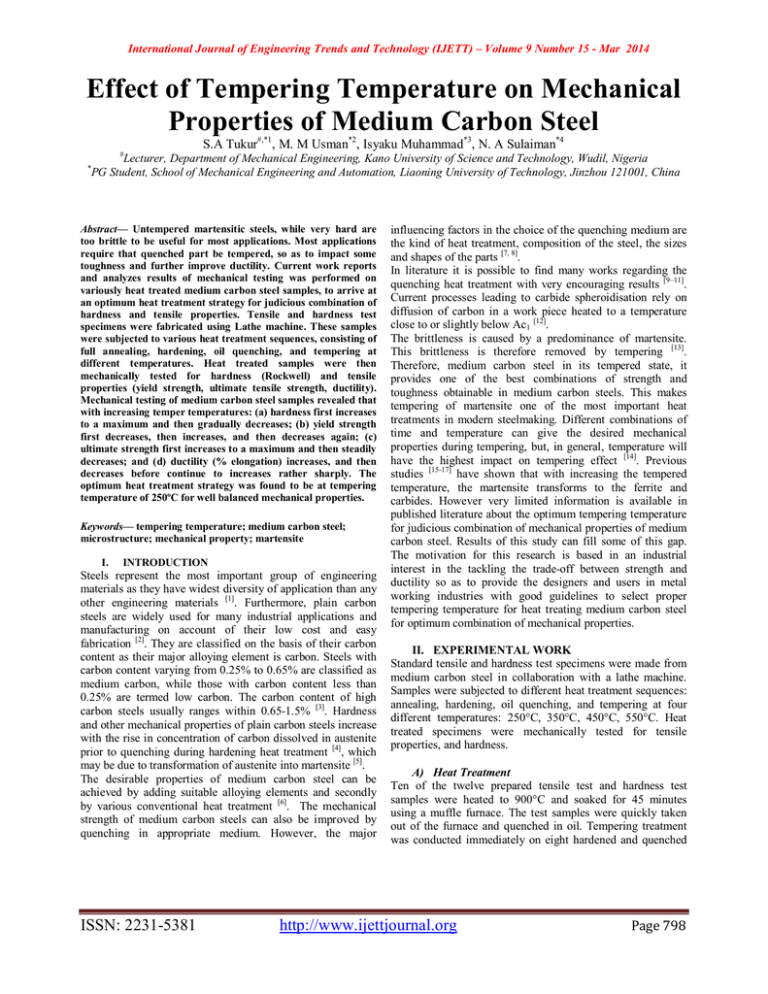
International Journal of Engineering Trends and Technology (IJETT) – Volume 9 Number 15 - Mar 2014 Effect of Tempering Temperature on Mechanical Properties of Medium Carbon Steel S.A Tukur#,*1, M. M Usman*2, Isyaku Muhammad*3, N. A Sulaiman*4 # * Lecturer, Department of Mechanical Engineering, Kano University of Science and Technology, Wudil, Nigeria PG Student, School of Mechanical Engineering and Automation, Liaoning University of Technology, Jinzhou 121001, China Abstract— Untempered martensitic steels, while very hard are too brittle to be useful for most applications. Most applications require that quenched part be tempered, so as to impact some toughness and further improve ductility. Current work reports and analyzes results of mechanical testing was performed on variously heat treated medium carbon steel samples, to arrive at an optimum heat treatment strategy for judicious combination of hardness and tensile properties. Tensile and hardness test specimens were fabricated using Lathe machine. These samples were subjected to various heat treatment sequences, consisting of full annealing, hardening, oil quenching, and tempering at different temperatures. Heat treated samples were then mechanically tested for hardness (Rockwell) and tensile properties (yield strength, ultimate tensile strength, ductility). Mechanical testing of medium carbon steel samples revealed that with increasing temper temperatures: (a) hardness first increases to a maximum and then gradually decreases; (b) yield strength first decreases, then increases, and then decreases again; (c) ultimate strength first increases to a maximum and then steadily decreases; and (d) ductility (% elongation) increases, and then decreases before continue to increases rather sharply. The optimum heat treatment strategy was found to be at tempering temperature of 250ºC for well balanced mechanical properties. Keywords— tempering temperature; medium carbon steel; microstructure; mechanical property; martensite I. INTRODUCTION Steels represent the most important group of engineering materials as they have widest diversity of application than any other engineering materials [1]. Furthermore, plain carbon steels are widely used for many industrial applications and manufacturing on account of their low cost and easy fabrication [2]. They are classified on the basis of their carbon content as their major alloying element is carbon. Steels with carbon content varying from 0.25% to 0.65% are classified as medium carbon, while those with carbon content less than 0.25% are termed low carbon. The carbon content of high carbon steels usually ranges within 0.65-1.5% [3]. Hardness and other mechanical properties of plain carbon steels increase with the rise in concentration of carbon dissolved in austenite prior to quenching during hardening heat treatment [4], which may be due to transformation of austenite into martensite [5]. The desirable properties of medium carbon steel can be achieved by adding suitable alloying elements and secondly by various conventional heat treatment [6]. The mechanical strength of medium carbon steels can also be improved by quenching in appropriate medium. However, the major ISSN: 2231-5381 influencing factors in the choice of the quenching medium are the kind of heat treatment, composition of the steel, the sizes and shapes of the parts [7, 8]. In literature it is possible to find many works regarding the quenching heat treatment with very encouraging results [9–11]. Current processes leading to carbide spheroidisation rely on diffusion of carbon in a work piece heated to a temperature close to or slightly below Ac1 [12]. The brittleness is caused by a predominance of martensite. This brittleness is therefore removed by tempering [13]. Therefore, medium carbon steel in its tempered state, it provides one of the best combinations of strength and toughness obtainable in medium carbon steels. This makes tempering of martensite one of the most important heat treatments in modern steelmaking. Different combinations of time and temperature can give the desired mechanical properties during tempering, but, in general, temperature will have the highest impact on tempering effect [14]. Previous studies [15-17] have shown that with increasing the tempered temperature, the martensite transforms to the ferrite and carbides. However very limited information is available in published literature about the optimum tempering temperature for judicious combination of mechanical properties of medium carbon steel. Results of this study can fill some of this gap. The motivation for this research is based in an industrial interest in the tackling the trade-off between strength and ductility so as to provide the designers and users in metal working industries with good guidelines to select proper tempering temperature for heat treating medium carbon steel for optimum combination of mechanical properties. II. EXPERIMENTAL WORK Standard tensile and hardness test specimens were made from medium carbon steel in collaboration with a lathe machine. Samples were subjected to different heat treatment sequences: annealing, hardening, oil quenching, and tempering at four different temperatures: 250°C, 350°C, 450°C, 550°C. Heat treated specimens were mechanically tested for tensile properties, and hardness. A) Heat Treatment Ten of the twelve prepared tensile test and hardness test samples were heated to 900°C and soaked for 45 minutes using a muffle furnace. The test samples were quickly taken out of the furnace and quenched in oil. Tempering treatment was conducted immediately on eight hardened and quenched http://www.ijettjournal.org Page 798 International Journal of Engineering Trends and Technology (IJETT) – Volume 9 Number 15 - Mar 2014 B) Mechanical Testing Mechanical tests were conducted on untreated, as-hardened and hardened-tempered samples to evaluate their tensile and hardness properties. A HV-1000 Rockwell type digital microhardness testing machine was used to conduct the hardness test measurements. Hardness values were determined by taking the average of five HRC readings at different positions on the test samples. Similarly, tensile test was conducted on untreated, as-hardened and hardened-tempered samples at room temperature using a 600kN Avery-Denison universal testing Machine. The ends of the specimen were gripped in the machine, and load was applied until failure occurred. The initial gauge length and diameter were measured before subjecting them to tension. The yield and maximum loads were recorded directly from the resulted graph, the broken ends of each of the specimens were fitted and the final gauge length and also the smallest diameter of the local neck were measured. The readings thus obtained were used in the determination of the yield strength, ultimate tensile strength, percentage elongation (ductility). III. RESULTS AND DISCUSSION Spectrometric analysis of the steel was carried out to determine its chemical composition. The result is shown in Table 1. S/N Elemen Weight S/N Elemen Weight ts % ts % 1 C 0.350 11 Co 0.015 2 Si 0.150 12 Nb 0.0050 3 Mn 0.760 13 Ti 0.0037 4 P 0.033 14 V 0.0057 5 S 0.034 15 W 0.010 6 Cu 0.05 16 Pb 0.0050 7 Cr 0.071 17 Sn 0.026 8 Mo 0.0050 18 Zn 0.0076 9 Ni 0.110 19 Fe 98.367 10 Al 0.025 Table 1 Composition of the steel sample investigated. A) Hardness Fig. 1 shows the micro hardness values of untreated, ashardened and hardened-tempered samples. As tempering temperature increases, hardness first increases to a maximum and then gradually decreases. Sample hardened at 900°C give the highest hardness value (24.2HRC) compared to asreceived and tempered counterpart. The steel material with approximate 0.35 carbon when heated to 900°C and soaked for 45mins, would have the carbon present dispersed to form austenite structures. The quenched specimens would have ISSN: 2231-5381 their austenites transformed to martensites. These are fine, needle-like structures which are very strong and hard, but very brittle. This increase in hardness can be attributed to the higher volume fraction of the harder martensite in the developed steel; the transformation of austenite to martensite by a diffusionless shear type transformation in quenching is also responsible for higher hardness obtained and this property is attributed to the effectiveness of the interstitial carbon in hindering the dislocation motion [18]. After the hardened steel tempered the prevalent martensite is an unstable structure and the carbon atoms diffuse from martensite to form a carbide precipitate and the concurrent formation of ferrite and cementite[3]. This allows microstructure modifications caused reduced in hardness level while increasing the ductility. The re-heating of martensites during tempering would enable it to be transformed into sorbite or troostite. These are fine dispersions of carbide in a ferrite matrix. 60 55 Hardness [HRC] samples at different temperatures of 250°C, 350°C, 450°C, 550°C with dwell time 30 minutes inside the furnace environment and allowed it to cooled in air to room temperature. 50 45 40 35 Untreated Hardned at 900 Tempered at 250 Tempered at 350 Tempered at 450 Tempered at 550 Sample Condition Fig.1: Variation of Hardness value of untreated, as-hardened and hardened-tempered samples against temperatures B) Strength Fig. 2 Compare the measured results of yield strength and ultimate tensile strength of untreated, as-hardened and hardentempered samples. Strength first increases to a maximum and then keeps on decreasing as temper temperature increases. The two curves are almost overlapping each other, indicating that there is only a marginal effect due to the difference in the heat treatment sequence. Maximum tensile strength of about 374MPa occurs at tempering of 250°C for the oil-quenched hardened-tempered samples. It should be noted that ultimate strength variation has almost the same pattern as hardness variation. This confirms that there is an almost direct relationship between hardness and strength, just as for most of the other steels. Similarly, the yield strength reached its maximum when hardened due to martensite formation as explained earlier and it then rapidly decreases after tempered at 250°C and continue to steadily decrease with increasing http://www.ijettjournal.org Page 799 International Journal of Engineering Trends and Technology (IJETT) – Volume 9 Number 15 - Mar 2014 tempering temperature. The decreased in strength observed was as a result of ferrite and cementite formed from the martensite. Tensile Strength Yield Strength 480 460 440 -tempered medium carbon steels was evaluated. The investigation reveals that the hardened samples give the highest hardness and strength values while highest hardness and strength values for the tempered samples was obtained at temperature of 250°C for medium carbon steels. 250°C was found to be an optimum temperature for well balanced mechanical properties. 420 400 REFERENCES Strength [MPa] 380 [1] 360 340 320 300 280 [2] 260 240 [3] 220 200 180 Untreated Hardned at 900 Tempered at 250 Tempered at 350 Tempered at 450 Tempered at 550 Sample Condition [4] [5] Fig.2: Variation of Strength of untreated, as-hardened and hardenedtempered samples against temperatures [6] C) Ductility [7] Fig. 3 shows the results of measured ductility of tested samples, against heat treated temperatures. The ductility of hardened sample was the least as compare to untreated sample, but increases when tempered at 250°C, with slight decrease at 350°C and 450°C and then increases sharply for the remaining tempered sample. This could be as a result of ferrite and cementite formed from the martensite. The highest value of ductility of about 50.9% was obtained on the sample with highest tempering temperature of 550°C. This is because tempering treatment at elevated temperature is able to increase the number of planes on treated sample for dislocation movement to occur. [8] [9] [10] [11] [12] 55 [13] Ductility [% Elongation] 50 45 [14] 40 [15] 35 30 25 [16] 20 Untreated Hardned at 900 Tempered at 250 Tempered at 350 Tempered at 450 Tempered at 550 Sample Condition Fig.3: Variation of Ductility of untreated, as-hardened and hardenedtempered samples against temperatures IV. CONCLUSIONS The influence of heat treatment process and temperature on mechanical properties of untreated, as-hardened and hardened ISSN: 2231-5381 [17] [18] M. S HTUN, S. T. KYAW and K.T LWIN, “Effect of Heat Treatment on Microstructures and Mechanical Properties of Spring Steel, Journal of Metals, Materials and Minerals, Vol. 18, (2) pp 191-192, 2008 Smith, W.F.; and Hashemi, J. 2006. Foundations of Materials Science and Engineering. 4th ed. McGraw-Hill, Ney York, NY, USA. Rajan, T.V.; Sharma, C.P.; and Sharma, A. 1988. Heat Treatment Principles and Techniques. Prentice-Hall of India Private Limited, New Delhi, India Thelning, K.-E. 1984. Steel and Its Heat Treatment. 2nd ed. Butterworth, London, England, UK. Feng, C.; and Tahir, I.K. 2008. The effect of quenching medium on the wear behaviour of a Ti-6Al-4V alloy. J. Mater. Sci. 43(2): 788-92. Rassizadehghani, J.; Raygan, Sh.; and Askari, M. (2006). Comparison of the quenching capacities of hot salt and oil baths. Metal Sci. Heat Treat. 48(5-6): 193-8. Motagi B.S and Ramesh B. (2012): Effect of Heat Treatment on Microstructure and Mechanical Properties of Medium Carbon Steel. International Journal of Engineering Research and Development. Vol. 2, Issue 1, Pp. 07-13. Jamiu K.O., Tajudeen K.A., Abdullarim B.R. (2012): Evaluation of Mechanical Properties of Medium Carbon Steel Quenched in Water and Oil. AU J.T. 15(4): Pp. 218-224. K.F. Wang,S. Chandrasekar,H.T.Y. Yang, Experimental and computational study of the quenching of carbon steel,J. Manuf.Sci. Eng. 119 (1997) 257–265. Y. Toshioka,Heat treatment deformation of steel products,Mater. Sci. Technol. 1 (1985) 883–892. J. Fuhrmann,D. Homberg,Numeric al simulation of the surface hardening of steel,Int. J. Numer. Method Heat Fluid Flow 9 (6) (1999) 705–724,MCB University press. Nam W. J. & Bae C. M. (1999), Coarsening Behavior of Cementite Particles at a Subcritical temperature in a medium Carbon Steel. Scripta Materialia, Vol. 41, No. 3, pp. 313-318, ISSN 1359-6462 Heat Treatment of Steel: Application and Heat Treatment of Society of Automobile Engineer, Carbon and alloy Steels, Machinery’s Hand Book, 1924 J.H. Hollomon and L.D. Jaffe. Time-temperature Relations in Tempering Steel. Metallurgical Transactions, 162:223–249, 1945. T. Senthilkumar and T. K. Ajiboye, Effect of Heat Treatment Processes on the Mechanical Properties of Medium Carbon Steel, Journal of Minerals & Materials Characterization & Engineering, Vol. 11, No.2 pp.143-152, 2012 Defa Li, Feng Huang, Shisen Wang et al, Effect of tempering temperature on microstructures and properties of niobium and titanium microalloying low carbon bainite steel, 2nd International Conference on Electronic & Mechanical Engineering and Information Technology (EMEIT-2012) LI Hong-ying, HU Ji-dong, LI Jun et al, Effect of tempering temperature on microstructure and mechanical properties of AISI 6150 steel, J. Cent. South Univ. (2013) 20: 866−870 Callister Jr; W.O. (1987), Material Science and Engineering. An introduction, John Willey, U.S.A pp 322-328 http://www.ijettjournal.org Page 800
